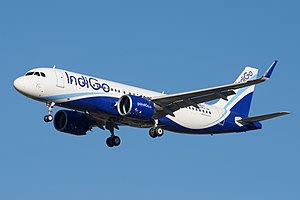A320neo
| A320neo family A319neo/A320neo/A321neo |
|
|---|---|
 |
|
| An A320neo about to land from IndiGo, the largest operator | |
| Role | Narrow-body twin-engine jet airliner |
| National origin | Multinational |
| Manufacturer | Airbus |
| First flight | 25 September 2014 |
| Introduction | 25 January 2016 with Lufthansa |
| Status | In service |
| Primary users |
IndiGo Pegasus Airlines Azul Brazilian Airlines |
| Produced | 2012–present |
| Number built | 70 as of 31 January 2017[update] |
| Unit cost | |
| Developed from | Airbus A320 family |
The Airbus A320neo family is a re-engine development of its A320 family of narrow-body airliners, launched on 1 December 2010 by Airbus, where "neo" means "new engine option", with a choice of CFM International LEAP-1A or Pratt & Whitney PW1000G engines. The original family is now called A320ceo, for "current engine option".
The first flight of the A320neo took place on 25 September 2014. It was introduced by Lufthansa on 25 January 2016. Airbus has 5,069 firm orders as of January 2017.
In 2006 Airbus started the A320 Enhanced (A320E) programme as a series of improvements targeting a 4-5% efficiency gain with large winglets (2%), aerodynamic refinements (1%), weight savings and a new aircraft cabin. At the time Airbus' Chief Operating Officer and executive member John Leahy said "Who's going to roll over a fleet to a new generation aircraft for 5% better than an A320 today? Especially if another 10% improvement might be coming in the second half of the next decade based on new engine technology".
Engine improvements reducing fuel consumption by 1% were fitted into the A320 in 2007 with the CFM56 Tech Insertion and in 2008 with the V2500Select (One).
Airbus launched the sharklet blended wingtip device during the November 2009 Dubai air show, their installation adds 200 kilograms (440 lb) but offers a 3.5% fuel burn reduction on flights over 2,800 km (1,500 nmi) Manufactured by Korean Air Aerospace Division, the 2.5 metres (8 ft 2 in) tall devices permits an annual carbon dioxide reduction of 700 tonnes per aircraft. The winglets increase efficiency by decreasing lift-induced drag.
...
Wikipedia
